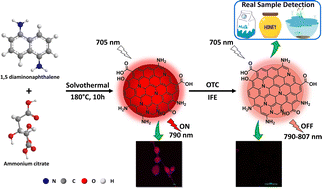Fluorescence switch based on NIR-emitting carbon dots revealing high selectivity in the rapid response and bioimaging of oxytetracycline†
Abstract
The abuse of antibiotics has led to serious environmental pollution and the emergence of drug-resistant bacteria surpassing the replacement rate of antibiotics. Herein, near-infrared fluorescent carbon dots (NIR-CDs) were developed to meet the requirements for oxytetracycline (OTC) detection in food and water samples (milk, honey, and lake water) with a detection limit of 0.112 μM. These NIR-CDs, possessing excellent water-solubility, deep tissue penetration ability, and tunable optical properties, exhibit maximum emission at 790 nm (NIR-I window). Unlike traditional CDs, this novel NIR-CDs nanoprobe provides a dual response in the presence of OTC (quenching and bathochromic shifting), without obvious interference from other existing biomolecules and metal ions. Additionally, these NIR-CDs exhibit excellent photostability and multi-resistance under UV irradiation, exceptional pH stability (pH 6–12), reliable long-time exposure, and durability in ionic (NaCl) environments. Moreover, NIR-CDs and NIR-CDs@OTC are nontoxic and were successfully utilized for cell-imaging applications in normal (NIH3T3) and cancer cells (HeLa).



 Please wait while we load your content...
Please wait while we load your content...